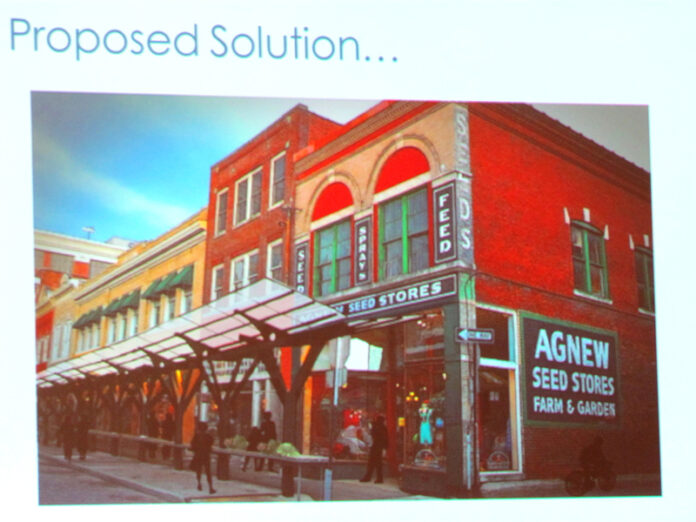
Replacing market vendor canopies every five years has become an increasing and expensive burden. “The canvas awnings are not really a long-term solution,” said Sean Luther, Downtown Roanoke Inc. CEO.
The city financed the current canopies with capital improvement funds several years ago and this spring they failed, said Luther. With the $250,000 price tag and frequency of replacement, he believes there needs to be a more reliable permanent replacement.
The solution, said Luther, is to use HUD grant funding that had been in search of a project. The cost is projected to be $242,000. The HUD grant’s limitations require that the funds be used specifically for market center improvements.
The canvas covers protect farmer’s market vendors, their stalls and pedestrian shoppers from sun and weather. The canopies first appeared in the 1970s as a part of “Design ‘79.”
The new style of protection will cover the vendors and pedestrian walkway with an optional magnetically attached drop cloth back cover. Although it looks like glass, the design uses a material called 3 Form which is made out of layers of bees wax and recycled plastic that protects vendors and pedestrians from UV rays while allowing for light filtration. It is the same material that was used for the Taubman Museum’s interior steps.
“DRI had been looking for the best use of the HUD funds given the limitations of the grant,” said Luther.
A local division of AECOM came up with a way to utilize the existing vertical structure of the farmer’s market to ramp up the process. “What we want to do is to find a way to improve the buying and selling experience on the market and improve the visibility of the inline retail,” said Luther.
The vendors are supportive of the design according to Luther. It will give a broader selling space with a lower impact on the retail, he said. The broader covering could also improve the capture of rainwater.
Included will be an upgrade for special effects lighting during holidays. Their next step will be a design vetting with the Architectural Review Board. With improved visibility of the historic buildings, Luther is confident that the ARB will approve the design. For now the concrete tables will remain and conversations with the vendors will continue on using less permanent immovable tables.
Replacement would begin in the off season with the project being completed by Easter 2013. The HUD funds must be used by September 2013.
City Manager Chris Morrill is fully behind the change saying, “The awnings are clearly more modern and will highlight the buildings.”

